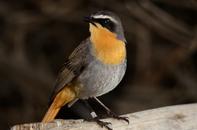
Name
Cape Robin-chat (Cossypha caffra)Cape Robin-chat Appearance
The Cape robin-chat has an orange breast and grey belly. The bird has a white eyebrow and a black band across the face. The Cape robin-chat has black legs. Orange tail feathers and back are visible in flight.Both sexes look alike. Juveniles are brown and heavily mottled.
Cape Robin-chat Diet
The Cape robin-chat is an insectivore and feeds mainly on beetles, ants, moths and caterpillars, taken on the ground.Cape Robin-chat Breeding
Monogamous, the Cape robin-chat mates and maintains a territory for life. The nest is very well hidden, close to the ground in a thick bush or old tree stump. The nest is a cup shape and is made from mud. Two to three eggs are laid and only the female broods the eggs.
The chicks hatch after around 18 days and are fed by both parents and fledge after 18 days. The brood parasite for the robin-chat is the red-chested cuckoo (Cuculus solitaries).